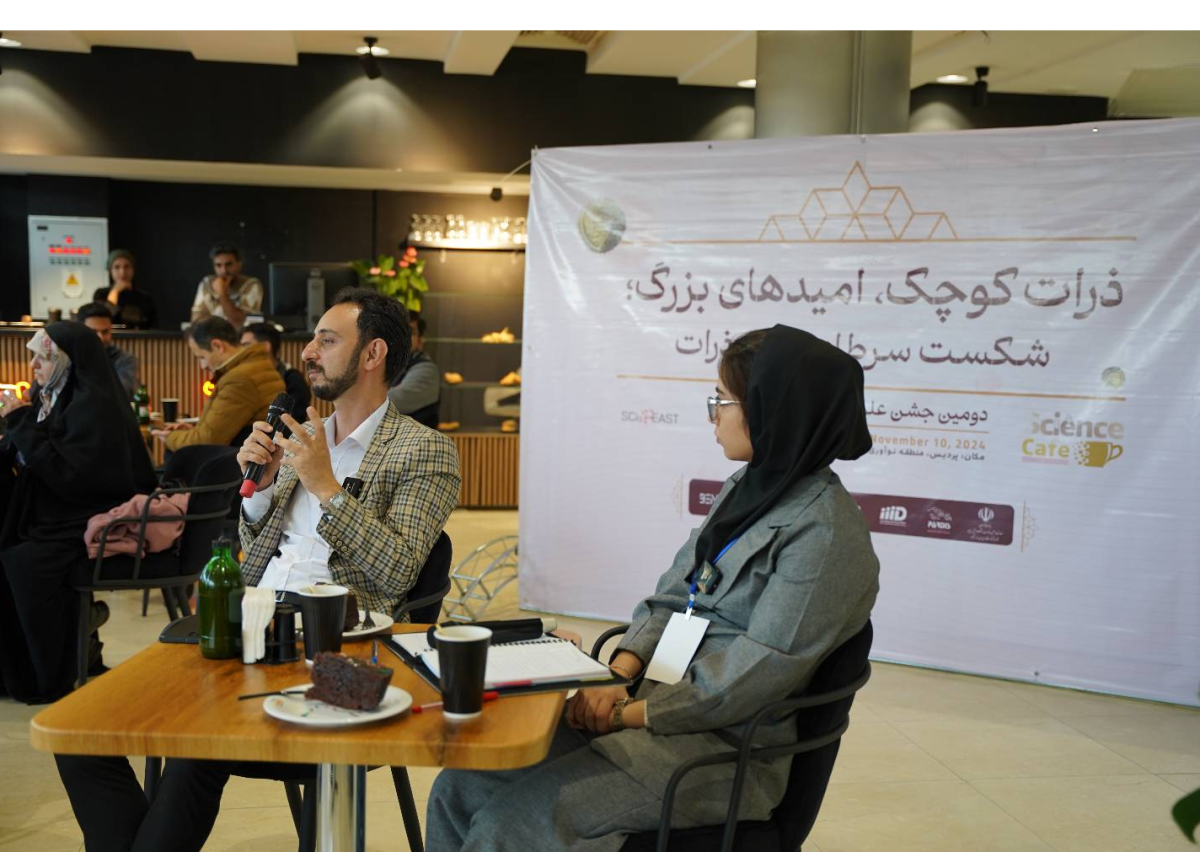Nanoparticles: Smart Soldiers in the Fight Against Cancer


The 23rd Mustafa (pbuh) Prize Science Café was held on November 14, coinciding with World Science Day for Peace and Development, at Pardis Technology Park, the largest technology park in the country. In this scientific program, the mechanism of nanotechnology in cancer treatment and the achievements of Professor Omid Cameron Farokhzad, the 2023 Mustafa (pbuh) Prize laureate, were shared with science enthusiasts in simple language.
MSTF Media reports:
In this scientific meeting, Dr. Sajjad Gharaghani, head of the Bioinformatics Group at the University of Tehran, as a special guest, explained to the program host how nanoparticles are used in cancer treatment.
The scientific and research achievements of Professor Omid Farokhzad, a distinguished scientist who was awarded the Mustafa (pbuh) Prize for his work in "design, development, and clinical evaluating novel drugs based on polymeric nanoparticles, " were the focus of the nanotechnology discussions at this event. In this conversation, the prominent features of nanoparticles and the challenges of using them were discussed.
Cancer: A Global Crisis in Need of Innovative Solutions
Cancer, this deadly and widespread disease, has always been one of the greatest challenges in medical science. Common treatments such as chemotherapy and radiotherapy, although somewhat effective in reducing tumor growth, significantly decrease the quality of life for patients due to their side effects.
The program host, while emphasizing the need for a more reliable and effective cancer treatment, pointed out the challenge of drug resistance. "The drug resistance of cancer cells, which gradually become capable of countering common cancer treatments, is another concern for researchers. Therefore, the need for new, less harmful, and more effective treatments seems more necessary than ever."
Nanoparticles: Tiny Particles with Great Therapeutic Potential
Nanoparticles, microscopic particles that are on the nanoscale (usually 10-9×1 meters), have attracted special attention in the field of biomedicine, especially in cancer treatment, due to their unique properties. These particles, due to their extremely small size and high surface-to-volume ratio, can exhibit unique properties that are not achievable with conventional treatments. Specifically, nanoparticles, due to their ability to cross biological barriers in the body and precisely target cancer cells, enable the delivery of drugs to specific parts of the body without damaging healthy tissues.
Dr. Gharaghani further explained: "For the use of nanoparticles in cancer treatment, the design and selection of the correct type of nanoparticle is essential. These particles must be able to pass through the body's immune barriers, deliver the drug directly to the cancer cells, and release it there."
Targeted Design of Nanoparticles: The Key to Successful Treatment
The biological system of the body is very complex and meticulously identifies and eliminates molecules that enter the body. Drug nanoparticles are no exception to this rule. To reach the target point and perform the therapeutic action, nanoparticles must have characteristics that able them to pass through the immune system's filters. Additionally, they must be lipophilic to cross the cell membrane, which has a lipophilic nature.
Given the specific characteristics of nanoparticles, one of the most important challenges in their use is the precise and targeted design of these particles. The performance of nanoparticles depends on their structural features. The ability of nanoparticles to interact with other molecules in the body, including proteins, plays a significant role in reducing side effects. Therefore, nanoparticles must be designed to identify and deliver drugs to the exact location of the cancer without damaging healthy tissues. For instance, in many types of cancer, cancer cells have an acidic environment that can be the starting point for the drug release process. Moreover, nanoparticles must be constructed to specifically bind to certain proteins on the surface of cancer cells, thereby delivering the drug to the target site.
Smart Nano Carriers
Using nano carriers for targeted drug delivery to cancer cells, due to their high precision in identifying the desired cells and directly releasing the drugs in that area, can significantly reduce the side effects of conventional treatments for this disease.
Professor Farokhzad demonstrated in his research that specific conditions must be met for drug release at the target site. According to these studies, for nanoparticles to identify cancer cells, specific functional groups must be placed on them. For example, folic acid, which is recognized by specific receptors on ovarian cancer cells, can specifically bind to the target cell and release the drug. In some cancers, specific proteins are expressed in the target cells; thus, nanoparticles must be designed to bind to these proteins and release the drug.
In the first report of the 23rd Science Café, we introduced nanoparticles and their role in cancer treatment, based on the Professor Farokhzad's achievements.
In the next report, we will address the challenges of this treatment method and its conditions in Iran.